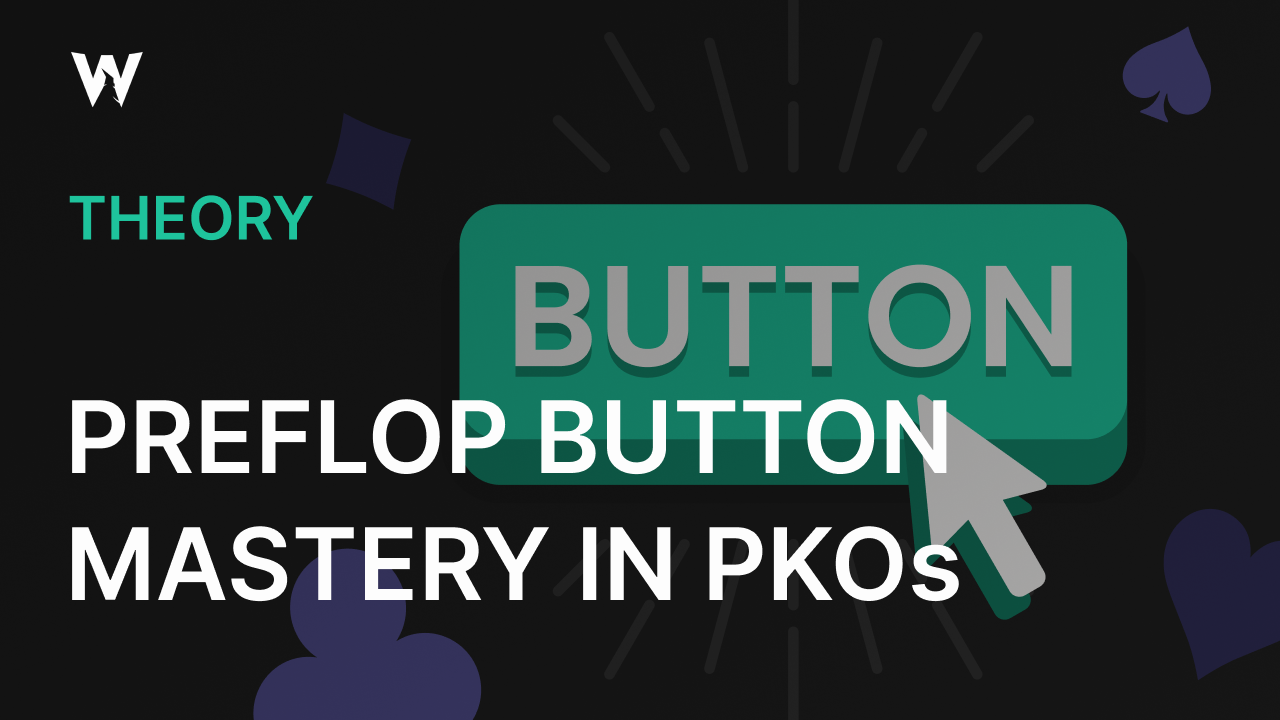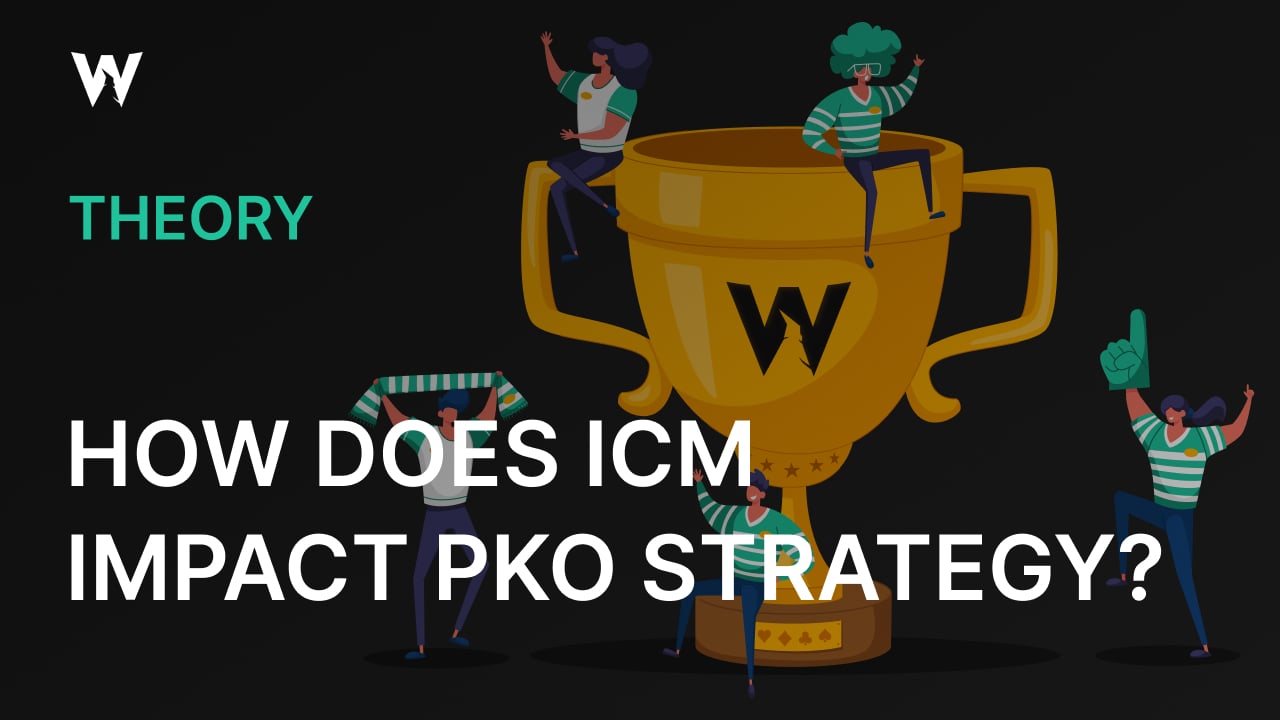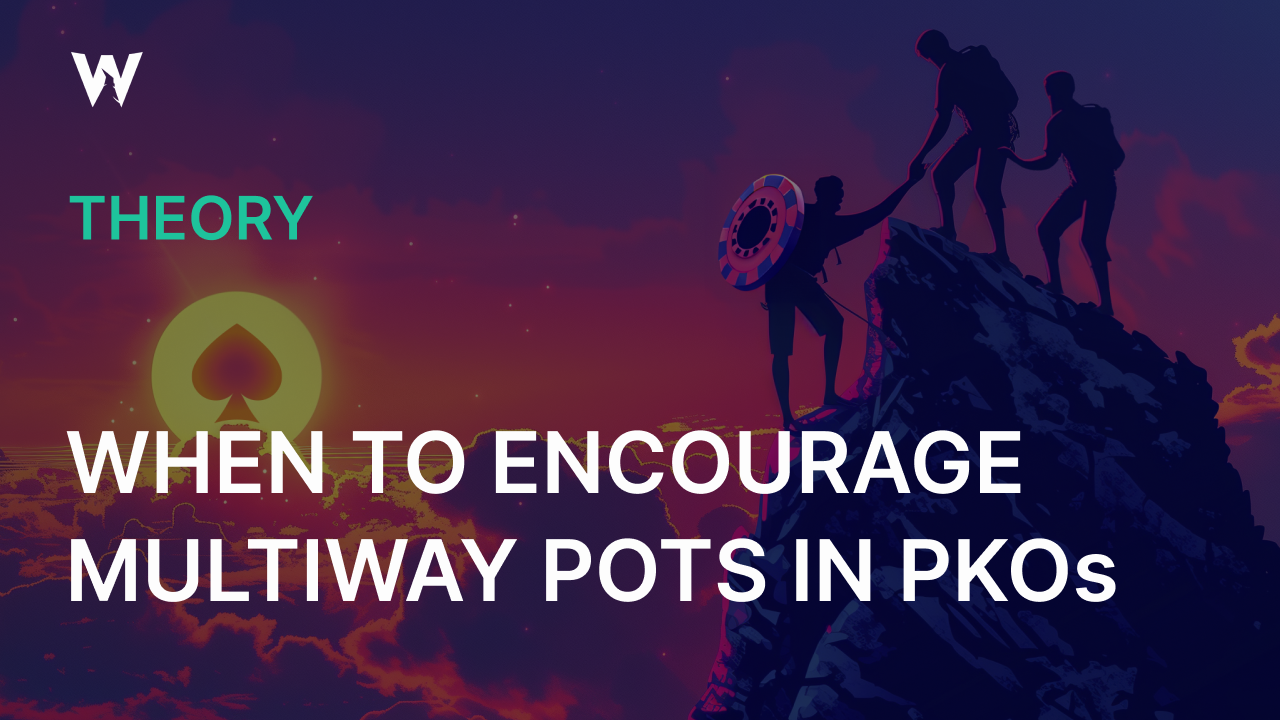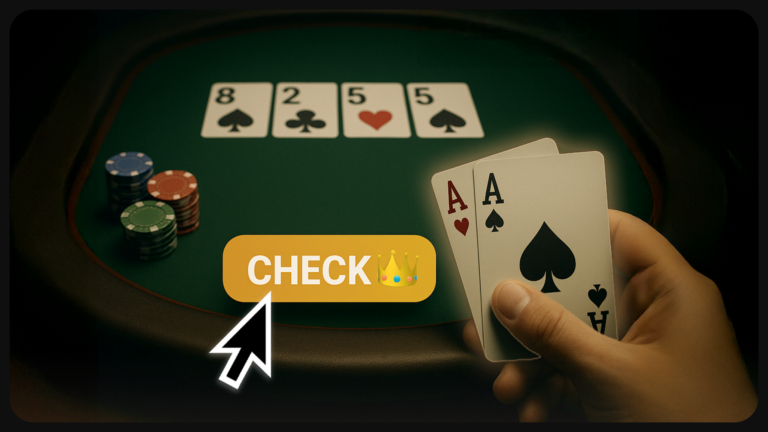A Champion’s Guide to Knockout Poker Formats
If you’ve opened any online poker client recently you will have seen an explosion of Knockout (KO) games in the schedule. With the variety of options available online, it can be daunting to figure out what games offer the best value to you and how to adjust your approach to these games, given their unique payout structures. Today, we will explore the current landscape of KO formats in poker and provide some strategy tips for each of them.
Standard Knockouts (SKO)
The Format
This is the original KO game format and the simplest to calculate bounty values for. 50% of the overall prize pool is allocated to the bounty prize pool, with each knockout granting you a claim to a bounty that is worth a fixed amount, typically half of the tournament buy-in. Even though Standard Knockouts have become less popular online in favor of alternative KO formats, they are still seen quite often live.
The Strategy
The chip value of bounties in KO tournaments decreases over time as chip values increase due to ICM. This effect is greater in an SKO tournament than in PKOs because the average bounty value in a PKO increases over time, resulting in greater mitigation of ICM pressure.
In practice, you should bounty hunt more aggressively when early in this format as the starting bounties convert to a higher bounty powerBounty power
Bounty power is used to convert the dollar value of a bounty in a poker tournament to a chip value, or vice versa. The bounty power formula measures the power of chips you control relative to the remaining prize pool. than the ones in a PKO tournament. We can assign a chip value to bounties in SKOs using the same method used in PKOs as described in the Theory of Progressive Knockout Tournaments article.
The flip side of this is that as the tournament progresses and we get closer to the money, the chip values of these standard bounties decrease more rapidly than progressive bounties. Based on this trend, we can use the PKO solutions available in GTO Wizard as a starting point, expanding on the given ranges slightly in the early stages of the tournament but playing closer to ICM in the later tournament stages.
Progressive Knockouts (PKO)
The Format
This is the most popular KO poker format but has the most complex strategy due to the variable bounty sizes throughout the tournament. Just like in the SKO format, 50% percent of the overall prize pool is reserved for bounty prizes. The difference is that when you knock an opponent out, the full value of the bounty is not paid out to you immediately. A PKO bounty gets split in half:
- Only one half of the total bounty is disbursed to the winning player
- The other half is added to that player’s own bounty
It is important to note that the winner of a PKO MTT not only wins the second-place player’s bounty but their own as well. This is the only way to get access to all those other halves of the bounties you collected.
Interestingly, while this format is primarily played online, there are some live tournament series (e.g., the World Series of Poker Circuit series) that have begun adding these formats to their schedules.
The Strategy
As there are several articles available on our blog that cover various aspects of PKO strategy, this article is intended to function more as a travel guide to the world of knockout poker; we will not go into strategic detail here. But we can summarize a couple of key considerations to keep in mind when playing a PKO tournament:
Stop overplaying your range – While bounty hunting is one of the key objectives in KO tournaments, it is important to balance this aspect with assigning proper value to our chips. For details on preflop hand selection, we’d encourage you to browse the GTO Wizard PKO solutions library for some practical examples of preflop range construction.
Stop overplaying your range – While bounty hunting is one of the key objectives in KO tournaments, it is important to balance this aspect with assigning proper value to our chips. For details on preflop hand selection, we’d encourage you to browse the GTO Wizard PKO solutions library for some practical examples of preflop range construction.
Play wider when covering and tighter when covered – In PKO tournaments, the effect of having more (i.e., covering) or less (i.e., covered) chips than another player is magnified, and as the gap between stack sizes increases, this effect gets even more pronounced. For some examples of just how wide our preflop range can get as the covering player, check out this article titled Preflop Button Mastery in PKOs.
Play wider when covering and tighter when covered – In PKO tournaments, the effect of having more (i.e., covering) or less (i.e., covered) chips than another player is magnified, and as the gap between stack sizes increases, this effect gets even more pronounced. For some examples of just how wide our preflop range can get as the covering player, check out this article titled Preflop Button Mastery in PKOs.
The chip value of bounties trends downward – This is because the monetary value of chips rises, on average, at a greater pace than the monetary value of progressive bounties. When expressing a bounty in chips, it will require fewer and fewer chips because they become more valuable more quickly. So, while bounties do have a significant impact on how to play PKOs, we need to consider the value of our chips when tournaments reach the stages where the influence of the payout structure becomes significant. Here’s a great read on How ICM Impacts PKO Strategy.
The chip value of bounties trends downward – This is because the monetary value of chips rises, on average, at a greater pace than the monetary value of progressive bounties. When expressing a bounty in chips, it will require fewer and fewer chips because they become more valuable more quickly. So, while bounties do have a significant impact on how to play PKOs, we need to consider the value of our chips when tournaments reach the stages where the influence of the payout structure becomes significant. Here’s a great read on How ICM Impacts PKO Strategy.
When facing an open or an all-in, we don’t always need to isolate – Passive play can be preferable when it encourages additional covered players to enter pots preflop with hands that would fold to aggression. More information on this aspect can be found in Barry Carter’s article on When to Encourage Multiway Pots in PKOs.
When facing an open or an all-in, we don’t always need to isolate – Passive play can be preferable when it encourages additional covered players to enter pots preflop with hands that would fold to aggression. More information on this aspect can be found in Barry Carter’s article on When to Encourage Multiway Pots in PKOs.
When short stacked, raise non-all-in to limit action – When you intend to go all-in as a covered player in a PKO, raising for most, but not all of your chips is preferable. For an explanation of the benefits of this strategy, check out Matt Hunt’s video on The Fake All-in.
When short stacked, raise non-all-in to limit action – When you intend to go all-in as a covered player in a PKO, raising for most, but not all of your chips is preferable. For an explanation of the benefits of this strategy, check out Matt Hunt’s video on The Fake All-in.
If this list of clues piqued your curiosity, you can find an explanation of them that steps into greater detail in this ‘Top Five PKO Tips’ video.
If this list of clues piqued your curiosity, you can find an explanation of them that steps into greater detail in this ‘Top Five PKO Tips’ video.
Mystery Bounties
The Format
This is the newest KO format and has seen the most popularization over the past two years. As with SKOs and PKOs, 50% of the overall prize pool is assigned to bounty prizes. Mystery bounties are preset for various unknown amounts, which are only revealed upon winning one. Depending on the tournament’s structure, bounties are either made available once players are in the money or on the second day of play if the tournament is multiday. Typically, a Mystery Bounty MTT will have bounties ranging from half a buy-in up to 100 or even 1,000 buy-ins.
Tournaments with this type of bounty have the highest variance in win rate since so much of the prize pool is assigned to only a couple of lucky knockouts in the money. It’s quite common for a single player to win more with a single knockout than the eventual winner of the tournament. This makes the Mystery Bounty format especially appealing to more recreational players who want to ‘gamble’ for a big win rather than trying to exert a skill edge to generate a consistent ROI.
The Strategy
In the Mystery Bounty format, players are incentivized to collect chips prior to the bounty phase to ensure they have the means to unlock as many bounties as possible. Once in the money, you can calculate the value of each player’s bounty in big blinds by using the following bounty power calculation:
Bounty value in big blinds = (((current bounty prize pool / number of players remaining) / Buy-in) × Starting Stack) / big blind in chips
Example 1: All Bounties Available
- $110 buy-in Mystery Bounty
- $500,000 prize pool, 50% assigned to bounties
- 50,000 starting stack
- 1,200 players ITM
Assuming blinds were 2,500/5,000 when the money bubble burst, a bounty would be worth the following the first hand of the ITMIn the money
Any finish in a poker tournament where the player has won money for their placement. Also known as “having cashed”. Often abbreviated to ITM. phase:
Bounty value in big blinds = ((($250,000 / 1,200) / $110) × 50,000) / 5,000 ≈ 19 big blinds
This might intuitively feel incorrect if you’re just being introduced to Mystery Bounties, but this is the impact of potentially winning an average of 2 buy-ins in a single hand. In practice, this means to call a UTG 5bb shove from the BTN when covering; you would be risking 5 big blinds to win effectively ~26bb with blinds and antes.
The practical implication on your strategy is that quite often when the largest bounties in a Mystery Bounty tournament are still up for grabs, your calling/shoving range when covering should be incredibly wide, significantly more than in any other KO format. Of course, if the largest bounties are taken out of the bounty prize pool, the bounty power will decrease significantly.
One consideration is that while the bounty value has a huge impact on our ranges, a large part of the bounty prize pool is locked up in two or three outliers, while the remainder follows a more even distribution. To have a more realistic representation of a mystery bounty’s value, let’s remove these outliers from our example and see how they impact the bounty power per player.
Example 2: Biggest Outlier Bounties Not Available
- $110 buy-in Mystery Bounty
- $500,000 prize pool, 50% assigned to bounties
- $100,000 top bounty, 2 $50,000 bounties, $50,000 for the remaining bounty prize pool
- 50,000 starting stack
- 1,200 players ITM
Assuming blinds were 2,500/5,000 at the start of the ITM phase, a bounty would be worth the following value in big blinds the first hand after the money bubble burst when we exclude the three top bounty values:
Bounty value in big blinds = ((($50,000 / 1,200) / $110) × 50,000) / 5,000 ≈ 3.7 big blinds
Now we have a much more reasonable outcome, with mystery bounties having far less of an impact on our overall strategy. While this approach doesn’t give you as many opportunities to hit that big jackpot win it will make sure you are making more realistic decisions when deciding what hands to call a covered player with.
Summary
KO format games offer a tremendous opportunity to find value outside of Classic format games, as many players are less familiar with their unique strategies. In this article, we outlined three distinct KO game formats and provided jump-off points into their associated strategies:
SKO (Standard Knockout)
In this format, we hunt bounties wider than in a PKO in the early stages of a tournament, as a bounty represents ½ of a buy-in rather than a ¼ of one. As the tournament progresses, we begin seeking out bounties less on average than we would in a PKO as chips increase in value, but the SKO bounties’ initial value remains unchanged.
PKO (Progressive Knockout)
With the ever-increasing dollar value of PKO bounties, it is important to understand when and how we hunt bounties. This bounty-seeking behavior needs to be balanced with standard tournament ICM as we reach the later stages of the tournament.
Mystery Bounty
This is the latest flavor of knockout tournaments. In Mystery Bounties, it becomes important to build a chip lead before making the money to ensure we are in a position to unlock as many bounties as possible. Once the money is reached, we can use the average of remaining Mystery bounties to determine the bounty power assigned to each player when covering them.
The BB’s incentives for calling an SB preflop raise differ from those of a cold-caller facing a raise from, say, LJ or CO. And the SB’s incentives for raising differ from those of an open-raiser in any other position.

Author
JonnyLaw
John Lawford AKA “JonnyLaw” is a mid stakes online MTT regular with a passion for the Progressive Knockout format.
Wizards, you don’t want to miss out on ‘Daily Dose of GTO,’ it’s the most valuable freeroll of the year!
We Are Hiring
We are looking for remarkable individuals to join us in our quest to build the next-generation poker training ecosystem. If you are passionate, dedicated, and driven to excel, we want to hear from you. Join us in redefining how poker is being studied.




























































































































































































































































